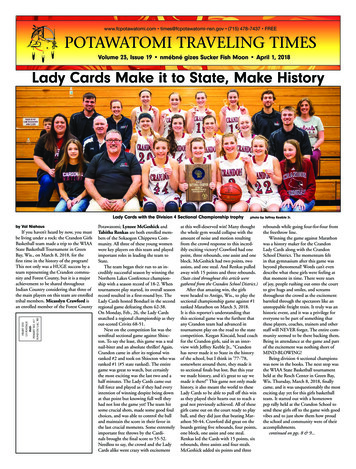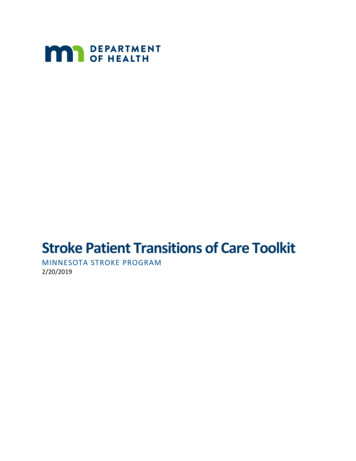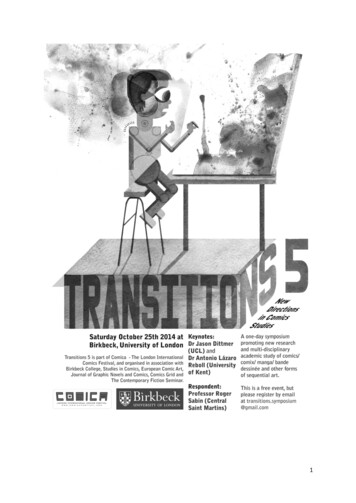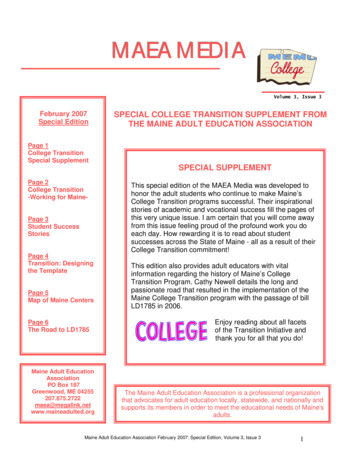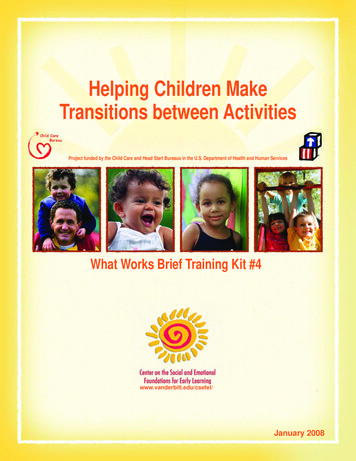
Transcription
Helping Children MakeTransitions between ActivitiesProject funded by the Child Care and Head Start Bureaus in the U.S. Department of Health and Human ServicesWhat Works Brief Training Kit #4www.vanderbilt.edu/csefel/January 2008
The What Works Brief Training Kits were developed to help in-service and pre-service providers conduct staff development activities. Each Kit is based on one WhatWork Brief and contains the following items: presenter’s PowerPoint note pages,participant handouts, activity ideas, pre-training survey, demographic form, trainingevaluation, and training certificate.The What Works Brief Training Kits are grounded in the Pyramid model depictedbelow which provides a framework for describing the four interrelated levels of practice that address the social and emotional development of all children. The Pyramidis designed to guide practitioners in understanding the importance of children’s socialemotional competence in terms of school readiness and the prevention of challenging behavior. This What Works Brief Training Kit relates to the “High Quality Environments” level of the Pyramid.We welcome your feedback as you provide professional developmentactivities with these materials.Special thanks to the Meginnis Endowment at UIUC for funding to helpsupport this effort and to the following individuals who developed the What WorksBrief Training Kits materials: Micki Ostrosky, Hedda Meadan, Greg Cheatham,Monique Mills, Sallee Beneke, Nancy Gaumer, Amy Hayden, Elenor Rentschler, andAngel Fettig.
Presenter NotesWWB Training Kit #4Helping Children MakeTransitions Between ActivitiesPresenter PowerPointSpeaker Notes: Presenter should be familiar with the content in What Works Brief #4 andModule 1 Section VII on Schedules, Routines and Transitions (available atcsefel.uiuc.edu). Welcome participants. Take care of any logistics (e.g, length of time for session, break, handouts,etc.). Consider using the What Works Brief # 4 handout as a supplementalresource. Pass out pre-training survey for all participants to complete and turn in, ifdesired. As you present the workshop:Remind participants to take the culture and background of children intoconsideration and to work hand-in-hand with parents when they selecttarget behaviors, since some behaviors may be part of the child’s culture.
Activity 1Pair-Think-Share Pair with a partner Read a scenario Think about why Share your thoughtsSpeaker Notes: Assign partners. Have half the group read one scenario and half read the other scenario. Pairs should think of reasons why the child in the vignette might be havingdifficulties. Share thoughts with the larger group by having one person read aloud avignette then all who worked on that vignette share their ideas. Repeat, focusing on the other vignette.
Activity 1What Is the Problem?MichelleMichelle is a 3-year-old girl. She enjoys playing in thekitchen center and interacting with friends. When theteacher announces that it is time to clean up and siton the carpet for group time, Michelle gets very upset.She throws toys and pushes other children. When theteacher comes near her, Michelle startsscreaming and saying that she is notfinished playing.Speaker Notes:Possible reasons for Michelle’s behavior that the group might come up with: The time is too short and Michelle barely gets into her play when it is timeto clean up She needs more warnings to anticipate cleanup time She does not like group time (it might be too long, too difficult, etc.) She does not understand what it means to “clean up”—how and where toput the toys away
Activity 1What Is the Problem?JimJim, a 4-year-old, is a new preschool student. He andthe other preschoolers in his classroom are playingon the playground. When Miss Johns calls them to goinside, they all gather next to the entrance door. Jimstays in the sandbox. When Miss Johns approacheshim and asks him to come with her, he startscrying and screaming, then drops to theground.Speaker Notes:Possible reasons for Jim’s behavior that the group might come up with: Jim is new and does not know the schedule The time is too short and Jim barely gets into playing in the sandboxwhen it is time to clean up Jim needs more warnings to anticipate cleanup time Jim does not like the activity that follows outdoor recess time Jim does not know why Miss Johns wants him to come with her andassumes he has done something “wrong”
Transition Transition refers to a change Types of transitions: Transitions between activities Transitions between multiple settings Transitions between programs We will focus on transition between activities.Speaker Notes: Define transition.Transition refers to a change (e.g., who provides services, what activitiesare available). There are 3 main types of transitions: Transitions between activities within a given setting (e.g., snack toplayground; outdoor recess to large group). Transitions between multiple settings on the same day (e.g., preschool toafter-school child-care program; Head Start program to child care). Transitions between programs (e.g., birth-three programs to preschool,preschool to elementary school). We will focus on transition between activities.
Why Is It Important to AddressTransitions Between Activities? Transitions take timeChildren often spend a lot of time waitingTransitions can be stressful and frustratingSkills such as cleaning up may reduce transition timesand may lead to more time for children to be engaged inactivitiesWhen children are taught what they “should be doing,” weare less likely to see problem behaviorsMany preschool teachers consider children’sability to independently make transitions akey skillSpeaker Notes: Transitions take a great deal of time During transition time, children often spend much time waiting (e.g., wait untileveryone has finished snack, wait for buses) Some children (and adults) have stressful and frustrating experiences duringtransitions between activities (e.g., children arguing over who took out whattoys and should put them away; children not knowing where to put certaintoys when they are done with them) Skills such as cleaning up toys and lining up may reduce transition times andmay lead to more time for children to become engaged in learning activities As children become independent and are taught what they “should be doing,”we are less likely to see problem behaviors. Many preschool teachers and other caregivers consider children’s ability tondependently make transitions between activities one of the essential skillsneeded in group contexts such as kindergarten and preschool.
Activity 2 Identify the transitions between activities in yourclassroom schedule. Complete the information in the table (seehandout).Speaker Notes: Refer participants to the handout. Have each person write down his/her classroom or program’s dailyschedule, noting each transition time between activities.
Identify Transitions times in yourclassroomTransition Time of day Transitionbetween whichactivities8:20-8:25Arrival frombuses and goto classroom8:25-8:30Put awaythings incubbies andcome to circleSpeaker Notes: We will complete this handout during the next 30 minutes. For now,complete Column 1 by listing the time of day and transitions betweenactivities. Discussion question: Do you have too many transitiond during the day?Are there some you can adapt or eliminate? How?
Strategies That Support SmoothTransitions Between ActivitiesBefore the Transition Plan your schedule to include a minimum number oftransition times Consider what the children and adults will do duringthese times Provide verbal and nonverbal cues before transitions Teach children the expectations for theroutine Minimize the number of transitions inwhich all children have to do the samething at the same timeSpeaker Notes:There are numerous strategies that support smooth transitions between activities.Examples of strategies you can use before the transition: Plan your daily schedule to include the minimal number of transition timespossible. Consider what the children and adults will do during these times (e.g., whichadult is responsible for greeting the children and who will begin looking atbooks on the carpet with children?). Provide verbal and nonverbal cues before transitions (e.g., “5 minutes ’tilsnack,” “It’s almost time for cleanup,” show pictures of the next activity, ringinga bell). Teach children expectations such as which shelves hold which blocks. Minimize the number of transitions during which all children have to do thesame thing at the same time (e.g., Do all children have to go to the restroomat the same time? Can some children come over to the rug and get ready forlarge group while others are finishing an activity?)
Strategies That Support SmoothTransitions Between ActivitiesDuring the Transition Sing songs, play word or guessing games, reciterhymes, or do finger plays with children Plan a gradual increase or decrease in the level ofactivity and a good balance of active and quiet play Allow children adequate time to finish activities Plan something for those children whofinish an activity quickly so they are notwaiting without something to doSpeaker Notes:Examples of strategies to use during the transition: Sing songs, play word or guessing games, recite rhymes, or do finger playswith children so that the time passes more quickly when they have to wait forlong periods of time for new activities to begin Plan a gradual increase or decrease in the level of activity (e.g., outdoor playfollowed by snack) and a good balance of active and quiet play (e.g., centertime followed by story time) Allow children adequate time to finish projects or activities so they do notbecome frustrated by activities ending too soon Plan something for those children who finish an activity quickly so they arenot waiting without something to do (e.g., if some children finish cleaning upand getting to large group quickly, might they look at books while waiting forother children to finish cleaning up?)
Strategies That Support SmoothTransitions Between ActivitiesAfter the Transition Provide positive attention or feedback to childrenfollowing smooth transitions Give very specific positive feedback after transitionsSpeaker Notes:Examples of strategies to use after the transition: Provide positive attention or feedback to children during AND followingsmooth transitions (e.g., when children pick up toys without muchprompting, tell them this shows how well they take care of their “things”and how much you appreciate their working independently). Give very specific positive feedback after transitions (e.g., “Nicholasand Jorge did a great job cleaning up the block area and moving to thecarpet.”).
Promote Independence During Transitions Allow children to move individually from one area toanother area when they complete an activity. Teach children to help one another. Help children self-monitor during transitions.Speaker Notes:Promote independence during transitions: Allow children to move individually from one area to another areawhen they complete an activity (e.g., as children finish snack, theyare encouraged to go to the carpet and choose a book; as childrenfinish putting away their coats and backpacks, they are encouragedto get a puzzle). Teach children to help others (e.g., have children move as partnersfrom one activity to another or ask one child to help another childgather his/her backpack). Help children self-monitor during transitions (e.g., children can beasked to think about how quietly or quickly they moved from oneactivity to another).
Activity 3TransitionStrategies to Time of dayuse before the Transitiontransitionbetween whichactivities8:20-8:25Arrival frombuses and goto classroomAdult is presentto greet and waitfor students;prompt childrento line up with abuddyStrategies touse duringthe transitionStrategies touse after thetransitionTeacher guidesdiscussionabout thingsthe childrensaw as theyrode the bus toschoolTeacher givesthe childrena “high 5” asthey enter theclassroomSpeaker Notes: Have participants take out their handout and fill in ideas (in Columns 2, 3,and 4) to consider within their schedule. The slide has one example on it—read this example aloud to the group. If necessary, have one participant share a transition time (and what it is likein his/her site and what problems he/she encounters during this transitiontime). Other participants can brainstorm strategies to use before/during/afteras a way to get the group started.
Individualize Transition StrategiesProvide support to children during transitions.Speaker Notes: Provide support to children during transitions: photos to help anticipate what activity is next directions given in a child’s home language or sign language an individual warning to a child that soon it will be time to clean up and begin anew activity Support may need to be individualized (i.e., one child may need an adult to providea 5-minute, 3-minute, and 1-minute warning before cleanup while the rest of theclass might only need a 3-minute warning) See if there are any concerns or general questions about the topic of transitionsbetween activities. Thank the participants for participating and have them complete the evaluationform, if appropriate. Distribute the certificate of attendance if appropriate.
Pre-training SurveyWWBTK #4: Helping Children Make Transitions between ActivitiesR Is it important to address transitions between activities in earlychildhood settings? Why or why not?CSEFELR What are two strategies you use to support transitions between activities inyour classroom?R What strategies do you use to promote independence during transitions?R What are the three most pressing issues you face as an early childhoodprofessional?1.2.3.
Pre-training SurveyWWBTK #4: Helping Children Make Transitions between ActivitiesDemographic InformationCSEFELDescribe yourself (check the boxes that best describe you):Your gender: Female MaleYour age: under 30 31 to 40 41 to 50 51-60 61 and aboveYour ethnicity: European American Asian-Pacific Hispanic African-American American Indian Other (specify)Check your current teaching certificates: Early Childhood Education Elementary Education Special Education Other (Specify)Check the one that best describes your education: High school or GED Some college Associate’s degree Bachelor’s degree Master’s degree Other (Specify)Your teaching experience:How many year(s) have you taught preschoolers?How many year(s) have you taught preschoolers with IEPs?Thank you for completing this survey.
Participant NotesNotesWWB Training Kit #4Helping Children MakeTransitions Between ActivitiesParticipant PowerPointTransition Transition refers to a change Types of transitions: Transitions between activities Transitions between multiple settings Transitions between programsWhy Is It Important to AddressTransitions Between Activities? Transitions take timeChildren often spend a lot of time waitingTransitions can be stressful and frustratingSkills such as cleaning up may reduce transitiontimes and may lead to more time for children to beengaged in activitiesWhen children are taught what they “should bedoing,” we are less likely to see problembehaviorsMany preschool teachers considerchildren’s ability to independently maketransitions a key skill
Strategies That Support SmoothTransitions Between ActivitiesBefore the Transition Plan your schedule to include a minimum numberof transition timesConsider what the children and adults will doduring these timesProvide verbal and nonverbal cues beforetransitionsTeach children the expectations forthe routineMinimize the number of transitionsin which all children have to do thesame thing at the same time Strategies That Support SmoothTransitions Between ActivitiesDuring the Transition Sing songs, play word or guessing games, reciterhymes, or do finger plays with childrenPlan a gradual increase or decrease in the levelof activity and a good balance of active and quietplayAllow children adequate time to finish activitiesPlan something for those children whofinish an activity quickly so they arenot waiting without something to do Strategies That Support SmoothTransitions Between ActivitiesAfter the Transition Provide positive attention orfeedback to children following smoothtransitionsGive very specific positive feedbackafter transitionsNotes
Promote Independence During Transitions Allow children to move individually fromone area to another area when theycomplete an activity. Teach children to help others. Help children self-monitor duringtransitions.Individualize Transition StrategiesProvide support or different types of support tochildren during transitions.Notes
Activity 1Pair-Think-ShareWWBTK #4: Helping Children Make Transitions Between ActivitiesDirections: Read the following case studies, think about the reasonsthe children might have difficulties, and share your thoughts with theperson next to you.CSEFELCase Study 1: MichelleMichelle is a 3-year-old girl. She enjoys playing in the kitchen center and interacting with friends. When the teacher announces that it is time to clean up and sit onthe carpet for group time, Michelle gets very upset. She throws toys and pushesother children. When the teacher comes near her, Michelle starts screaming andsaying that she is not finished playing.Case Study 2: JimJim, a 4-year-old, is a new preschool student. He and the other preschoolers inhis classroom are playing on the playground. When Miss Johns calls them to goinside, they all gather next to the entrance door. Jim stays in the sandbox. WhenMiss Johns approaches him and asks him to come with her, he starts crying andscreaming, then drops to the ground.
Activity 2 and 3Pair-Think-ShareWWBTK #4: Helping Children Make Transitions Between ActivitiesDirections for Activity 2: Identify at least 5 transitions betweenactivities in your classroom schedule and complete the informationin the first column of the table.CSEFELDirections for Activity 3: For each transition you identify inActivity 2, add strategies you could use before, during, and afterthe transition.Transition Time of day Transitionbetween whichactivitiesStrategies to use Strategies to use Strategies to useafter theduring thebefore thetransitiontransitiontransition
CSEFEL Training Workshop EvaluationWWBTK #4: Helping Children Make Transitions Between r position:R Circle the number that best expresses your reaction to eachof the following items:1. This topic is important to me.(Extremely Important) 4 3 2 1 (Not Important at All)2. The amount of information covered was(Just Right)4 3 2 1 (Inadequate)3. The information covered was clear.(Very Clear)4 3 2 1 (Vague)4. The activities conducted were beneficial.(Very)4 3 2 1 (Not at All)5. The handouts provided were useful.(Very)4 3 2 1 (Not at All)6. Overall, this presentation was(Very Useful)4 3 2 1 (Not Useful)R Things I liked about this presentation:R Things I would change about this presentation:R Additional information I would like on this topic:R New things I am going to try as a result of this workshop:R Additional comments:
Cer tificate of TrainingHelping Children Make Transitions between ActivitiesThis is to certify thatsuccessfully completed the above trainingTrainerParticipantTrainerDate and LocationAdditional training resources are available at: http://www.vanderbilt.edu/csefel/
Consider what the children and adults will do during these times (e.g., which adult is responsible for greeting the children and who will begin looking at books on the carpet with children?). Provide verbal and

